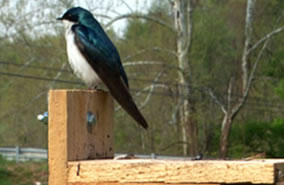Human Health
| About USGS / Science Topics / Maps, Products & Publications / Partnerships / Education / Newsroom / Jobs |
|
Animal Sentinels of Human Health
Animals often are the first to come in contact with the microbes, contaminants, and pollutants that can make people sick. Animal symptoms and responses to conditions around them can serve as an early warning system for potential threats to human health.
The canary in the coal mine is a classic example of how animals are sentinels of human health. Caged canaries, being more sensitive than humans to the effects of carbon monoxide and other poisonous gases, saved lives in the early 1900s by alerting miners to the presence of dangerous gas.
Today, earthworms, swallows, bats, other wildlife, and even our pets are all animal sentinels alerting us to disease, allergens, and contaminants in our environment. USGS scientists are designing and monitoring these sentinel systems to help you and public health officials take preventative actions before serious health consequences such as disease outbreaks can occur.
Links to USGS Sentinel Research Projects
- Sentinels of Health Threats from Dust and Air
- Sentinels of Health Threats from Drinking Water
- Sentinels of Health Threats from Human Consumption
- Sentinels of Health Threats from Recreational Waters
- Sentinels of Health Threats from Vector Borne and Zoonotic (animal to human) Disease
More Information
- Animals as Sentinels of Human Environmental Health Hazards
- Animals as Sentinels for Bioterrorism: from Journal of the American Veterinary Medical Assn.
- Animals as Sentinels of Human Health Hazards of Environmental Chemicals: from Environmental Health Perspectives
- Pets as Sentinels of Environmental Cancer Risk: from Environmental Health Perspectives


